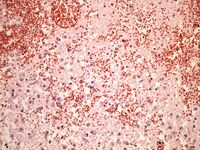Infarct
Infarction is a focus of ischemic necrosis in an organ or tissue that is caused by the occlusion of a supply artery. It is the most severe form of ischemia. In the vast majority of cases, a heart attack is caused by the blockage of an artery by a thrombus or embolus. It is rarely caused by bleeding into the atherosclerotic plaque with its subsequent sudden enlargement, e.g. in a. coronaria.
Morphology[edit | edit source]
The typical macroscopic appearance does not develop until 48 hours after arterial occlusion. Most infarcts are wedge-shaped with the artery closed at the tip and with the base directed to the periphery of the organ.
According to color, we divide into:
- Light, anemic - arise in stiffer tissues of a solid consistency (myocardium, kidneys, spleen) and in the brain. Often its cause is the closure of terminal arteries that have no anastomoses.
- Red, hemorrhagic - the dark red color is conditioned by the bleeding of necrotic tissue. They arise in thinner tissues where there are abundant anastomosing vascular branches (lungs, intestine).
- Mixed - white infarct with extensive hemorrhagic rim.
Microscopic image[edit | edit source]
- Coagulative necrosis - is the most common, occurs in the lungs.
- Collivation Necrosis - in the brain.
- Gangrene - often in the lower limbs, typically in patients with [[diabetes mellitus|diabetes].
If the occlusion is caused by an infected embolus'' or if the necrotic tissue is secondarily infected from the surrounding area, the infarction turns into an abscess - a so-called festering infarction. Furthermore, a red infarct can also become discolored, during which the erythrocytes break down, releasing hemosiderin and bilirubin into the environment. Macroscopically, a local icterus develops. Infarcts are generally healed by granulation tissue and later by scar (e.g. retraction of the surface of the kidney, chronic aneurysm in the LV of the heart). The exception is in the brain, where a post-malacia pseudocyst remains, which is a cavity filled with colliculated necrotic tissue.
Clinical Significance[edit | edit source]
Heart attacks are among the most frequent and serious clinical disorders. In developed countries, myocardial infarction causes 20% of deaths, the next most common cause of death is brain infarction - so-called encephalomalacia'. Pulmonary infarctions complicate about 10% of all cases of pulmonary embolization. Intestinal infarctions, which have a high mortality rate, are less common. Ischemic necrosis is a frequent complication in diabetics - it has the character of wet or dry gangrene.
Links[edit | edit source]
Related Articles[edit | edit source]
References[edit | edit source]
- PROMOTED, Ctibor – ŠTEINER, Ivo – DUŠEK, Paul. General Pathology. 1. edition. Prague : Galen, 2011. 290 pp. ISBN 978-80-7262-773-8.



